If you have recently gotten a tattoo and are now seeing bruising around it, you may be wondering why this is happening. In this article, we will discuss the possible causes of tattoo bruising and what you should do to care for your tattoo. We will also provide tips on how to prevent bruising from occurring in the future. By understanding why your tattoo is bruised, you can maintain its appearance and keep it looking its best.
Contents
What Is Tattoo Bruising?
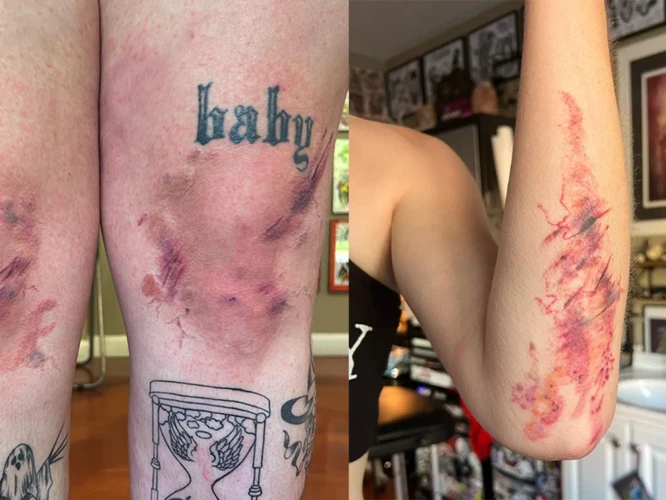
Tattoo bruising is a common side effect of getting a tattoo. It is caused by the trauma from the tattoo needle, which causes small blood vessels to burst and leak blood. This blood then pools underneath the skin, causing a purplish-blue hue. While this bruising is usually temporary and fades away within a few days, it can last up to a few weeks in some cases. The amount of bruising depends on the size and area of the tattoo and how deep the needle penetrated the skin. It is important to note that the amount of bruising does not reflect the quality of the tattoo; it is simply a normal side effect.
How long do tattoo bruises last? The amount of time it takes for a tattoo bruise to heal depends on the individual and how much trauma was inflicted on the skin. Generally, bruises will last anywhere from a few days to a few weeks. In some cases, the bruising can last longer, so it is important to follow the aftercare instructions given by your tattoo artist.
What Causes Tattoo Bruising?

Tattoo bruising can be caused by a few things. The most common cause is the needle that is used to create the tattoo. When the needle penetrates the skin, it can cause trauma to the area. This trauma can cause blood vessels to break, leading to a bruise. The size and intensity of the bruise can vary depending on the size of the needle and how deep it is inserted into the skin. It can also depend on how much pressure is applied to the skin when the needle is pushed into it.
Another factor that can cause a tattoo to bruise is the type of ink used. Some inks are thicker than others, and may cause more trauma to the skin. This trauma can cause the tissue to break down, leading to a bruise. The level of bruising will also depend on how much ink is used and how quickly it is injected.
Lastly, the healing process can cause a tattoo to bruise. As the tattoo is healing, the skin can become inflamed and irritated. This inflammation can cause the blood vessels to break, resulting in a bruise. It is important to properly care for a tattoo while it is healing to minimize the risk of bruising.
Why do tattoos bruise? Tattoo bruising can be caused by the needle used to create the tattoo, the type of ink used, and the healing process. To minimize the risk of bruising, proper care should be taken before, during, and after the tattooing process.
What Does Tattoo Bruising Look Like?
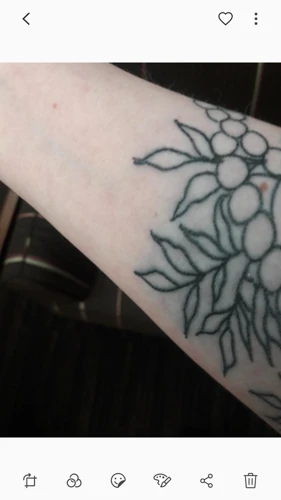
Tattoo bruising is a common occurrence when getting a tattoo. It is a normal side effect from the trauma of the tattoo needles and can last for several days. The bruising can vary in intensity and size, but typically appears as:
- Purple or blue patches around the tattoo, usually appearing within a few hours of getting the tattoo.
- Swelling around the tattoo which can last for several days.
- Pain and tenderness around the tattoo.
- Discoloration of the area, which can last for several weeks.
Tattoo bruising should not be confused with infection, which typically appears as redness, swelling, and pus. If any of these signs are present, it is important to contact your tattoo artist or doctor for further advice.
How Long Does Tattoo Bruising Last?
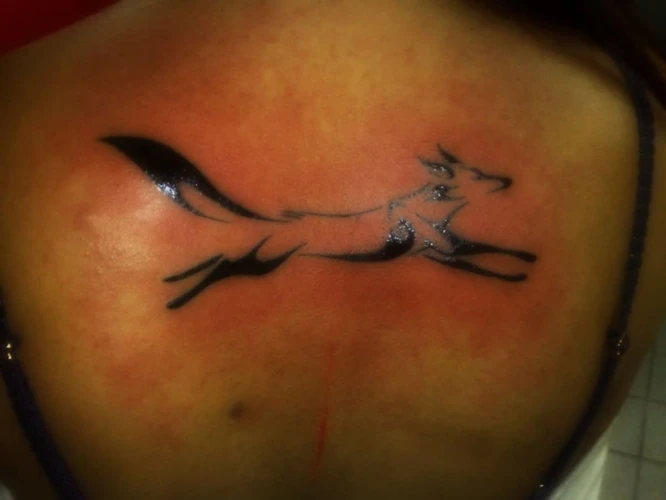
Tattoo bruising is a common side effect of tattooing and is caused by trauma to the skin due to the needle puncturing it. Bruising may last for several days or even weeks, depending on the size and depth of the tattoo.
- The size and complexity of the tattoo design will affect the length of time it takes for the bruising to heal.
- If the tattoo is particularly deep, the healing process may take longer and the bruising may last for up to a few weeks.
- Tattoos that are placed in areas that are more susceptible to bruising, such as the biceps or ribs, may take longer to heal and the bruising may last longer.
- The amount of tissue that is being tattooed will also affect the length of time it takes for the bruising to heal.
- The healing process can be accelerated by keeping the area clean and applying moisturizer to keep the tattoo moist.
What happens if you tattoo over a bruise? Tattooing over a bruise can cause more trauma to the skin, leading to more bruising and an increased healing time. It is best to wait until the bruise has completely healed before getting a tattoo. Additionally, it is important to keep the area clean and to avoid any activities that could cause more trauma to the skin.
What Happens if You Tattoo Over a Bruise?
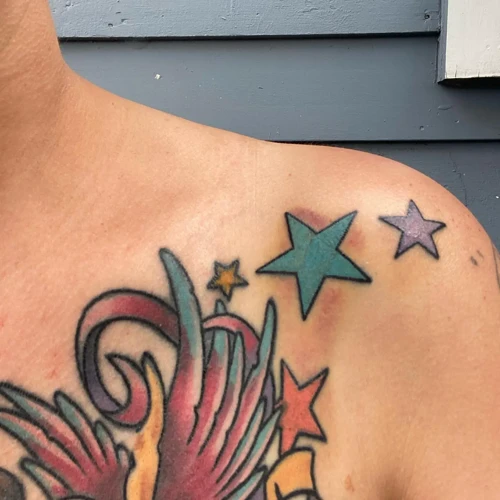
Tattooing over a bruise is not recommended and can be dangerous. Doing so may lead to ink pigment getting trapped in the bruise, resulting in a distorted tattoo and increased risk of infection. Additionally, the pressure of the tattoo needle could make the bruise worse, and the trauma of the needle can cause additional bruising.
If you have a bruise, wait until it has healed before getting a tattoo. If you already have a tattoo that is bruised, you should see a doctor for advice and for treatment.
The best way to avoid getting a bruised tattoo is to take care of your skin before and after getting a tattoo. Make sure you keep the area clean and moisturized, and avoid activities that can cause excessive bruising until your new tattoo has healed.
If you must get a tattoo over a bruise, there are some precautions you can take.
| Precaution | Description |
|---|---|
| Avoid excessive pressure | Lightly tapping the needle is better than pressing hard, as too much pressure can cause more bruising. |
| Use thin needles | Thinner needles are less likely to cause additional bruising. |
| Choose lighter ink | Using lighter ink can help prevent pigment from getting trapped in the bruise. |
Ultimately, tattooing over a bruise is not recommended, as it can cause complications and distort the tattoo. If you have a bruise and want to get a tattoo, wait until it has healed before getting inked. Taking care of your skin before and after getting a tattoo can also help reduce the risk of bruising when getting a new tattoo.
What Can You Do to Prevent Tattoo Bruising?
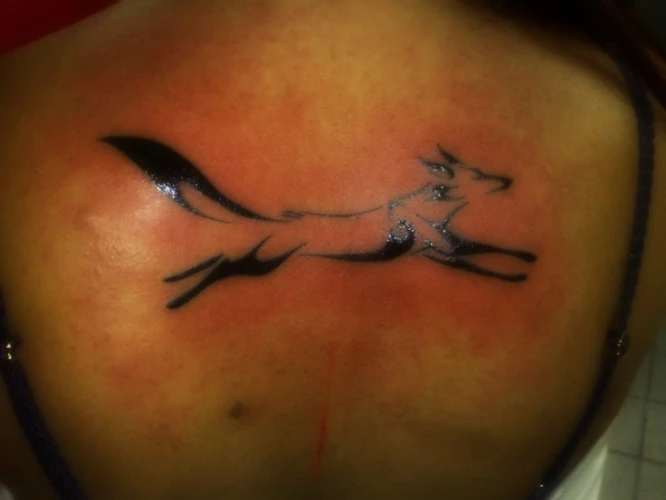
Take care of your skin: Make sure to keep your skin healthy and hydrated by eating well, drinking plenty of water, and using a moisturizer. This can help to avoid the conditions that can lead to tattoo bruising.
Avoid excessive sun exposure: Too much sun exposure can damage the skin, which can lead to tattoo bruising. Be sure to wear sunscreen and a hat when outdoors.
Use a topical anesthetic: Many tattoo artists offer a topical anesthetic that can help reduce the pain and discomfort of the tattooing process. This can also reduce the likelihood of bruising.
Get plenty of rest: Make sure to get plenty of rest before and after getting a tattoo. A rested body can better handle the stress of the tattooing process, thus reducing the risk of bruising.
Be mindful of the tattoo artist: Make sure the tattoo artist is experienced and has a good reputation. Poor technique or poor hygiene can cause excessive trauma to the skin, leading to tattoo bruising.
Be aware of when does tattoo bruising go away: Tattoo bruising typically lasts for a few days, but it can take up to a few weeks for the bruises to completely disappear.
What Should You Do if You Have Bruised Tattoos?
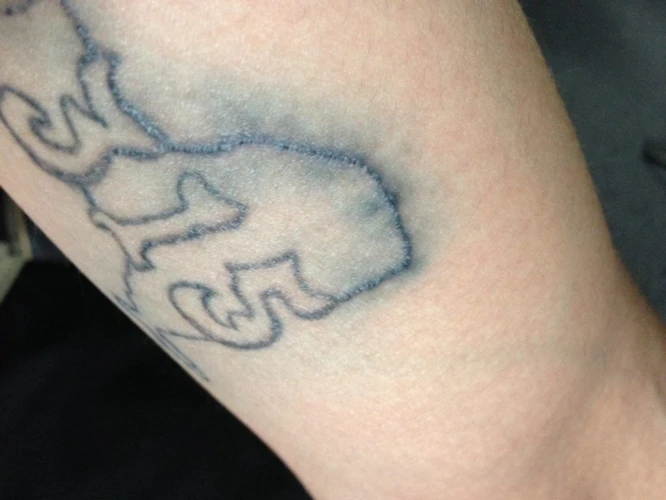
If your tattoo has become bruised, the best course of action is to seek medical advice from your tattoo artist or doctor. Your tattoo artist can advise you on how to care for the bruise, and your doctor can diagnose any underlying cause. In some cases, a bruise on a tattoo may be a sign of an infection or allergic reaction.
If your tattoo is bruised due to trauma, such as a blunt force or impact, the best course of action is to keep the area clean and dry. If the bruise is particularly large or painful, you can apply a cold compress for up to 20 minutes at a time to reduce swelling. Avoid using ointments or creams on the bruised area, as this may cause further irritation or infection.
If you notice that the skin around your new tattoo is yellow, this could be a sign of an allergic reaction. If this is the case, you should visit your doctor for further diagnosis and treatment. Allergic reactions can be caused by a variety of factors, including the type of ink used, the placement of the tattoo, or the body’s reaction to the needle. Your doctor can provide you with the best advice on how to care for your skin and prevent further allergic reactions.
Why Is My New Tattoo Bruised?
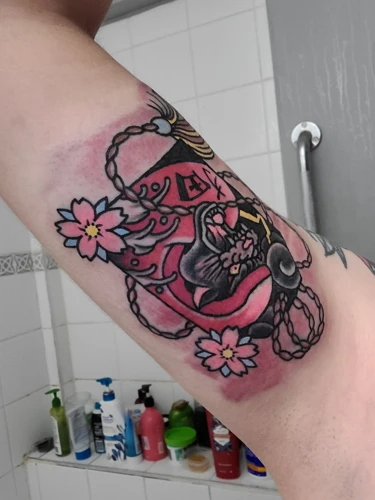
Getting a new tattoo is always an exciting experience, but sometimes there may be a surprise waiting for you – bruising. Tattoo bruising is common, but it can be disconcerting and leave you wondering what’s going on. Here’s a look at why your new tattoo may be bruised, and what you can do about it.
What Causes Tattoo Bruising?
- The most common cause of tattoo bruising is trauma to the skin caused by the needles.
- The trauma can cause the blood vessels to break, which leads to the pooling of blood, resulting in bruising.
- The amount of bruising depends on how deep the needle penetrates the skin and how many times the artist has to go over the same area.
- If the artist is inexperienced or goes too deep, it can increase the chance of bruising.
How Long Do Tattoo Bruises Last?
- Tattoo bruises usually last from one to two weeks, depending on the severity of the bruising.
- The area may be tender for the first few days, and the color of the bruise may change from black and blue to yellow and green before fading away.
Why Do Tattoos Bruise?
- Tattoos bruise because of the trauma to the skin caused by the needles.
- The trauma can cause the blood vessels to break, which leads to the pooling of blood, resulting in bruising.
- The severity of the bruising depends on how deep the needle penetrates the skin and how many times the artist has to go over the same area.
What Does Tattoo Bruising Look Like?
- Tattoo bruising typically looks like a black and blue mark on the skin.
- The bruise may be tender and inflamed, and it may be larger than the area that was tattooed.
- The color may change from black and blue to yellow and green before fading away.
What Happens If You Tattoo Over a Bruise?
- If you tattoo over a bruise, it can make the bruise worse and cause more trauma to the skin.
- It can also cause the ink to spread, which can lead to an uneven appearance.
- It’s best to wait until the bruise has completely healed before getting a tattoo.
Why Is the Skin Around My New Tattoo Yellow?
- The yellow color around a new tattoo is usually caused by the body’s natural healing process.
- The yellow color is caused by an accumulation of white blood cells and fluids, which form a protective layer around the wound.
- This layer will eventually fade away, revealing the true color of your tattoo.
Tattoo bruising is a common and usually harmless occurrence, but it can be unnerving. Knowing why it happens and what you can do about it can help put your mind at ease. If you have any concerns about your tattoo bruising, it’s best to consult your tattoo artist or a healthcare professional.
When Does Tattoo Bruising Go Away?
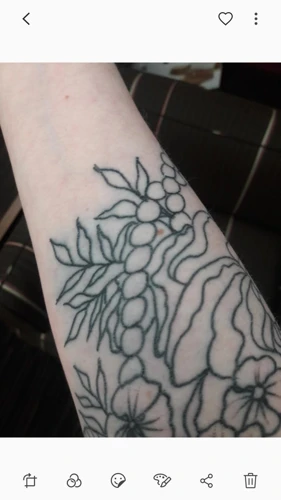
Tattoo bruising is a common side effect of having a new tattoo, though it is often short-lived. Generally, tattoo bruising should start to fade away within a few days, though it may take up to a week or more for the bruising to completely disappear.
The exact amount of time it takes for tattoo bruising to go away will vary depending on the size and location of the tattoo, as well as the individual’s healing process. The tattoo artist may also be able to provide approximate healing times based on the specific tattoo.
Tips for speeding up the healing process:
- Keep the tattoo clean and moisturized with a mild, fragrance-free lotion.
- Avoid activities that may irritate the area, such as swimming or soaking in a hot tub.
- Avoid exposing the area to direct sunlight or tanning beds.
- Do not pick at or scratch the area.
- Apply a cold compress or ice pack to reduce swelling.
If the tattoo bruising does not go away within a week, or if it is accompanied by other symptoms such as redness, swelling, pain, or oozing, it is best to contact a healthcare professional. They can assess the area and provide advice on how to best treat the tattoo and ensure a successful healing process.
Why Is the Skin Around My New Tattoo Yellow?
Tattoos may appear bruised after a session, but yellow discoloration is also common. This is usually caused by the deposition of ink beneath the skin. This can cause the skin in the area to take on a yellowish hue, which is most noticeable around the edges of the tattoo. It is important to note that this discoloration is not permanent and should fade over time.
The yellowing is caused by the body’s natural healing process. The skin produces a pigment called bilirubin, which is yellow in color. The body produces this pigment in response to the trauma of the tattooing process and it collects in the area of the tattoo. The yellow color will usually fade over time as the body absorbs the pigment.
To help minimize the yellow discoloration, it is important to keep the tattoo clean and dry. Clean the area with a gentle soap and water and pat dry with a clean, dry cloth. Apply a thin layer of an unscented, hypoallergenic moisturizer to the area to keep it hydrated. Finally, avoid exposing the tattoo to direct sunlight for the first few weeks.
In some cases, the yellow discoloration may persist for longer than expected. If this is the case, it is important to seek medical advice from a doctor or dermatologist. It is important to rule out any underlying medical conditions, such as an infection, that may be causing the discoloration.
Frequently Asked Questions
What can I do to prevent a bruised tattoo?
Avoid Alcohol and Caffeine Before the Session: Both alcohol and caffeine can thin your blood, which can make your skin more susceptible to bruising. Avoiding both before your appointment can reduce your chances of bruising.
Don’t Take Blood Thinners: If you are on blood thinners, talk to your doctor about taking a break from them for a few days before your tattoo session.
Choose a Professional Artist: Working with a professional tattoo artist means they will have the right tools and techniques to reduce the risk of bruising.
Stay Hydrated: Keeping your body hydrated is key when it comes to preventing bruises. Drink plenty of water throughout the day leading up to your appointment and keep drinking while you are getting your tattoo.
What are the Risks of Having a Bruised Tattoo?
Having a bruised tattoo can lead to infection, scarring, and permanent discoloration of the skin. It is important to take proper care of your tattoo to avoid the risks associated with bruising. If your tattoo is bruised, it is important to seek medical attention as soon as possible to ensure proper healing and avoid further complications.
Is it Safe to Touch or Scratch a Bruised Tattoo?
Touching or scratching a bruised tattoo can cause further damage and increase the risk of infection. It is important to avoid touching a bruised tattoo, as bacteria from the hands can cause an infection. If itching occurs, gently pat the area with a clean cloth or paper towel to relieve the itch. To reduce swelling or discomfort, apply a cold compress to the area. If the bruise persists or is accompanied by other symptoms such as redness, swollen skin, or fever, seek medical attention.
How long does a bruised tattoo take to heal?
It depends on the size and severity of the bruise. Generally, a bruised tattoo will take anywhere from four to eight weeks to heal, although healing times can vary depending on individual factors.
- Keep the area clean: The most important factor in the healing process is to keep the tattooed area clean. Wash the area twice a day with a mild soap and warm water. Pat the area dry with a clean cloth and apply a thin layer of a nourishing ointment or lotion.
- Avoid picking or scratching: Picking or scratching a bruised tattoo can cause further damage. This could lead to infection or permanent scarring.
- Avoid direct sunlight: Use sunscreen to protect the tattooed area from the sun’s harmful rays. Sun exposure can cause the tattoo to fade and can slow down the healing process.
- Avoid swimming: Chlorinated water and bacteria in pools, hot tubs, and other bodies of water can cause infection and can slow down the healing process.
- See a doctor: If the area becomes red, swollen, or painful, seek medical attention immediately. These symptoms could indicate an infection.
Following these steps can help to ensure that your tattoo heals properly and without any further complications.
Are There Any Medications or Treatments That Can Help a Bruised Tattoo Heal Faster?
No medications or treatments can speed up the healing process of a bruised tattoo. The best way to help it heal is to keep the area clean and dry, apply an ointment or lotion to keep the skin moisturized, and practice proper aftercare. Avoid activities that can aggravate the bruise, such as swimming and excessive movement. If necessary, a doctor can prescribe antibiotics to help prevent infection.
Conclusion
Tattoo bruising is a common side effect of getting a tattoo. It is usually harmless and will disappear within a few days to a few weeks. However, if the bruising is accompanied by other symptoms such as swelling, pain, or oozing, it could be a sign of an infection. If that happens, you should seek medical attention immediately. Taking the proper aftercare steps can help reduce the risk of bruising and infection.